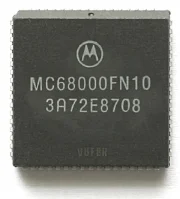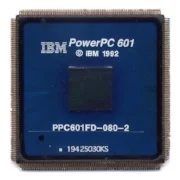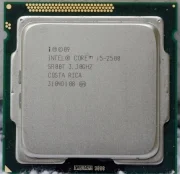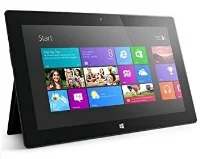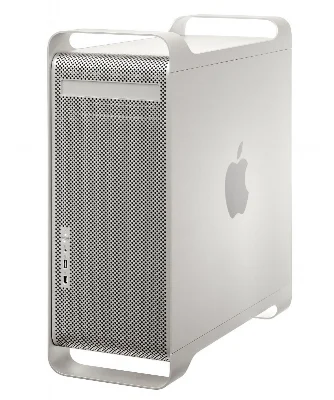Internet golden rule: Nothing is ever as good, or bad as people say.
When Apple introduced the new controversial new design Mac Pro at WWDC in June, the tech world exploded with interest. "It looks like a trash can," was the most common sentiment. "Jet engine" and "Darth Vader's escape pod" are also popular. Nobody seems to know what to make of it.
In the imaging world however, the technical aspects of the machine are being harshly criticized. The lack of any sort of legacy expansion slots and ports and indeed any ability to upgrade or modify the machine after purchase is being almost universally decried.
Is it really the second coming of satan himself? Or merely the inevitable evolution of the professional workstation.
The king is dead, long live the king!
The Mac Pro has long been the go to workstation for professionals, especially imaging professionals. It has the speed, reliability, and expandibility required by people who actually make a living from their workstation. It was, (and still is) a very expensive system. If your workflow requires a ton of power and 24-7-365 reliability, then it's definitely worth the price.
In 2009, after owning a huge chunk of the visual workstation market for years, Apple mysteriously stopped updating the Mac Pro. iMacs and MacBooks got new features like SSD drives and fast IO ports, but the Mac Pro was still stuck on the same silicon and features as it had for years. There was a lot of speculation that Apple had decided to exit the professional workstation market just as it had the enterprise market a couple years earlier. Couple that with the stagnation of all of Apple's professional software packages and it was beginning to look bleak for the Apple pro customer. And then hallelujah! Apple hath wrought a new Mac Pro!
Except it's unlike any professional workstation ever seen before; no expansion slots? No internal drive bays? No upgradability? How is this professional?
A new kind of "professional"
Looking back it can safely be said that Apple wasn't exiting the professional market so much as re-evaluating it. The cost/benefit equation of selling high end hardware and software to a small group of people wasn't as attractive as it had been in the nineties when they made up the majority of Apple's customers. However, instead of leaving the market altogether, Apple decided to re-define the professional customer.
Ironically enough, all this started with the redefinition of consumer computing ticked off by the iPhone and other next-gen smartphones in 2007. These mobile devices fulfilled the basic needs of the average consumer, and more importantly they are always on and always connected; something laptop and desktop PCs could never do. They do their job so well in fact that some people are claiming the "end of the PC era."
Nobody liked that phrase more than Apple Computer Inc. For years they had been fighting to get people to see them as the anti-PC. The well known "Mac vs PC" ad campaign was pretty successful, and was a big part of changing the consumer perception that computing had to be difficult. They succeeded in painting the "PC", and indeed computing in general as being a hassle, and painting themselves as the easier, simpler, (and at the same time more powerful) option. They even dropped the "Computer" from their name to reflect the change.
The Macintosh, and especially Mac Pro, (and professional user) became the biggest casualty of the vast success that Apple, and all the other smartphone and tablet vendors have seen in the last half-decade. The problem with making a vastly easier and more convenient (and affordable!) consumer computer is that consumers will stop buying the more powerful systems that used to be Apple's bread and butter and that subsidized all the developers working on the pro apps.
Apple wasn't the only company struggling with it's professional apps. Many professional application vendors hadn't done a major feature upgrade to their software in years. Most pro apps are languishing on decade(s) old 32bit code bases even though 64bit chips have been around for years. On top of that, pros (and their accounting departments) didn't want to pay for more software upgrades. Many vendors started lengthening their development cycles or moving to subscription models to subsidize their development teams. But these are half measures and will only lead to even less money for development in the future.
Fortunately, Apple foresaw this potential dilemma, and moved to counteract it. Instead of finding a way to charge the customer more for the same product, Apple decided to do the same thing that had given them success in consumer hardware. They made the product easier to use (some would say simplified) and lowered the price. They hoped this would open up their pro apps to more people and they would sell more, recouping the cost of rebuilding the apps as they went along.
Final Cut Pro was the first app to get this treatment, and judging from the backlash, maybe Apple should have started elsewhere. I'm not going to rehash that debacle, but lets just say that Apple was unprepared for the response it received. Looking at it now however, it seems they might have been right…
With the rise of online video and the video-fication of every camera in existence, the opportunity to create a whole new prosumer customer base has never been bigger. And no-one is positioned to take advantage of the craze except Apple. Think about it; Premiere is too expensive for a prosumer to consider, especially with the required monthly subscription. Even if they had the money, the learning curve is steep. Sony might be able to get some traction with it's Vegas suite, but it's windows only. Nobody else has a big enough consumer mindshare to even play in the game.
I'm not going to get into the "is Final Cut Pro X good enough for professionals" debate because it's outside the scope of this article, and because it's stupid... Professionals, (as in people who get paid to make videos) are using it right now for all levels of projects, (don't believe me? Watch this:) and are perfectly happy with it. The only reason I bring it up is it goes right to the heart of the issue. Apple is trickling professional down to the masses. They are enabling anybody to be a pro if they want to be. That's what Final Cut was about, and that's what this new Mac Pro is about.
The common man's Mac Pro
What does all this have to do with the Mac Pro? It's still a $3000+ computer system that requires a even larger overall investment in peripherals to get the most out of. It's hardly cheap enough to sell it to college students and little old ladies. While it’s true that the Mac Pro will never be cheap, the new model is more accessible… Simpler, easier to use or at least to understand. The old school Mac Pro was an imposing behemoth of a system. Just looking at it you get the feeling that you better not touch it unless you know what you are doing. And that’s not far off the mark. Installing stuff in a computer is an exercise that a relatively few people are brave/knowledgable enough to attempt. Your mom doesn’t upgrade her computer, she gets someone to do it for her or she scraps it and buys a new one. Most consumers do. Every computer user knows how to plug in a peripheral though.
And that’s what makes the new Mac Pro different. It’s small, quiet and unassuming. It’s very approachable, and even beautiful. It’s self-contained, and everything you would want to do with it is as simple as plugging in a cable. Technophiles forget that not everybody is or even wants to be a computer guru. Some of them just want to retouch their photographs, make music, or edit videos and they want their computer to get out of the way. Many of these same people are also actually professionals, (in that they make a living from their work). What Apple has done is make a pro level workstation that anybody can be comfortable using. Well heeled prosumers will gladly pay for a machine this powerful that doesn't make them feel like a dummy.
The least expandable Mac Pro ever?
The old school Mac Pro is a fairly expandable machine. It has four PCI slots, six SATA ports and eight RAM slots, as well as replaceable processors. It can be extended and upgraded in a load of different ways. However, as a professional video editor, I can tell you categorically that it is not expandable enough. I work in a small studio with around a dozen other editing or graphics related professionals. We have a good mix of Mac Pros ranging from brand new 2012 twelve-core systems to quad-core dinosaurs from 2006. Before that we were using G5’s and G4’s. And none of them has ever been fast or expandable enough…
Pro video guys will tell you that you can’t ever be rich enough, good-looking enough and you can never have enough CPU, RAM, or storage in your system. Six SATA ports will never support the amount of storage you need. At my studio we edit off a 100TB+ Xsan… And back in the dinosaur age we all had twelve drive external SCSI RAIDs. Try fitting that in your Mac Pro.
It’s the same story with expansion cards. I would love to install a second graphics card to take advantage of enhanced rendering speed in Maya, After Effects, and Final Cut X, or maybe a USB3 card to download my SSDs faster, but the systems are full. Graphics card in slot 1, video interface in slot 2, Fibre Channel card in slot 3, and P2 (or other) card interface in slot 4. The old school Mac Pro doesn’t have what it takes to handle everything I should be able to throw at it.
You know what does though? Any macbook with a thunderbolt port… I’m serious. Six devices per port means I can connect to my display, SAN, video interface, and three more devices. All from a single cable. When I realized this, I replaced my Mac Pro with a 15” Macbook Pro and never looked back. Now before I get complaints let me just state that yes an old school Mac Pro has more total bandwidth than a thunderbolt port. But in this case that doesn’t matter because a single port has ENOUGH bandwidth, and supports more devices than an old school Mac Pro. I use this setup to capture 444 uncompressed video directly off a camera and onto a SAN and it performs flawlessly.
That’s just a Macbook with a single thunderbolt port… Imagine the new Mac Pro with six thunderbolt 2 ports. That’s 36 devices and double the total bandwidth of the old school system. And just to sweeten the deal you get a second graphics card thrown in! It’s smaller than a 2 liter bottle of soda, nearly silent, it supports six displays, and has the fastest boot drive anyone has ever shipped. Why would anybody want the old school system? This thing is a video editors dream!
Problems that will get solved
The only legitimate complaint that I see is that, (at least for the moment) nothing can be upgraded on the new Mac Pro. Now, I think that enterprising Mac upgrade vendors will figure this one out within the year, but lets say they don’t… It’s still cheaper to sell an old system and roll the money into a new one then upgrade. I know a lot of accounting departments don’t see it that way, but Apple computers hold their value so well it’s an easy argument to win.
The only other complaint I will even entertain is that the cost of thunderbolt peripherals is too high. If you look at the whole market of devices, you will see that this isn’t the case. Most of the peripherals I buy are a similar cost or slightly cheaper. The only exception is external drives, where the extra cost of a thunderbolt chip can double the cost of the drive. In that case it’s Intel and the drive manufacturers that need to get on the ball and bring the costs down. Until that happens, it’s definitely a good idea to just stick to USB3 storage. It is dirt cheap and platter drives don’t push enough data to saturate USB3 much less thunderbolt.
Needless to say, if you have a lot of old school expansion cards and bare hard drives it’s going to cost you a lot to upgrade. It’s probably best to wait until you need to obsolete those devices for whatever reason. Remember this is a professional workstation. If your time isn’t actually money then you should probably look at getting a more spartan system.
Old school vs. new school
There is a larger movement at work here though that we need to examine. The old guard of technophiles in our families, the press, IT departments and yes even in the ranks of imaging professionals, is being obsoleted. Computing isn’t the realm of the knowledgeable and trained anymore. From the boardroom to the editing suite, it’s secrets can’t be kept. The technophiles are afraid because their arcane knowledge for the most part is no longer necessary. The barriers have been broken down, and in that sense maybe it is the “end of the PC era.” Many of them will lose their jobs. The talented ones will adapt and move forward as they always have. Skill is still the most needed quality in any business.
Those that try to stall the winds of change however, will fail. Apple didn’t start this trend and they won’t be the ones to end it. All they did is see the wave forming and get out in front of it. Everybody yelling at Apple for losing their way would be better served updating their skill sets so that the wave doesn’t come crashing down on them. I would also like to remind them that it doesn’t matter how many drive bays your computer has, only how much work you can get done with it.
Mario Colangelo has been a video editor, camera operator, systems engineer, and SAN wrangler for eight years.







